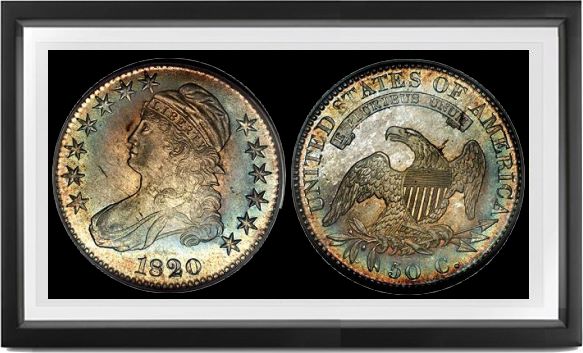Park Avenue Numismatics
5084 Biscayne Blvd, Suite 105
Miami, FL 33137
Toll Free: 888-419-7136
Secure Private Ordering
We use the latest online security processing,
so your order is safe & private.
We DO NOT disclose any customer
information to ANY third party company.
Our customer privacy is our priority.
Over 30 Years Experience
Park Avenue has over 30 years
experience buying and selling
Rare Coin and Precious Metals.
We have the knowledge and
ability to provide our customers
with the best products and services.




CAPPED BUST HALF DOLLARS, LETTERED EDGE (1807-36)

ACCORDING TO MINT DIRECTOR, JAMES ROSS SNOWDEN, (using mint documents no longer located), the change of design to the new John Reich devices took place in September 1807, some 750,500 being struck from four obverse and three reverse dies. The new design, showing a buxom Ms. Liberty wearing a mob-cap inscribed with her name, was at once attacked for portraying "the artist's fat mistress," though the design remained with numerous minor modifications until 1836.
The 1807-08 coins have the largest heads and eagles. In 1809 a revised version appears, giving Ms. Liberty a shorter neck, larger ear, and shorter curls with small triple ringlet below "R." The 1811/10 (11 over 10) has been touted as a rarity; this obverse die was either worn down quickly or reground, effacing the zero, and specimens with a clear zero are rare.
Coins of 1812-15 were again modified, the hubs here showing coarse high relief curls. Despite the Guidebook listing, the 1812/11 with large 8 is many times rarer than that with small 8, first being reported in December 1969; to date fewer than a dozen are known in all grades as against several hundred of the other. The same head reappears on the 1817/13 and 1817/14. The latter was discovered in 1930 and despite vigorous search only four specimens are known as of the present writing. From 1814 through 1830 the edge lettering shows a star after DOLLAR but no lines between words. The scarce issued dated 1815 was delivered on Jan. 10, 1816, the day the Mint reopened; on the next day a fire destroyed the rolling mills so that no silver or gold strip could be made for cutting out blanks until near the end of 1817.
In 1817 another modified head was introduced, showing finer curls in lower relief, only a few fine curls below "LI"; in 1818-24 a fifth head, this one similar but with many fine curls below "LI" and other minor differences in the hair. In this period many overdates occur and there are additional varieties from changes in style of one or more digits or letters, five different styles of date being found in 1820 alone. At the end of 1827 a curve based 2 was introduced; this is rare in full Mint State. Of the five types found in 1828, the squarebased 2 with large 8's and the small letter coins are grossly undervalued compared to the rest; in 1830, by far, the rarity is the small "O" coin with large reverse letters (no. 114 in the Overton book on halves); this is so rate that for generations its existence was controversial, and fewer than four are traced even now.
Two experimental edges were in use in 1830-31. The first of these has plaques between words with diagonal lines slanting down to right; this is rare on 1830, extremely rare on 1831. The second has similar plaques but diagonal lines slanting down to left; this is extremely rare on 1830, rare on 1831.
In 1834 there are not only the three major types (of which the large date and letters come first), there is also a large 4 over small 4. The final date, 1836, is notable for three different styles of 5 and large or small "C's" in "50 C."; the corrected blunder 50/00 (50 over 00) is rare in all grades, very rare with sharp 00—four being known in Proof State. Another scarce one has 1836/1336 with ST of "STATES" corrected from IT—all evidence of great haste in diemaking.
Click here to view our current inventory of Capped Bust Half Dollars











